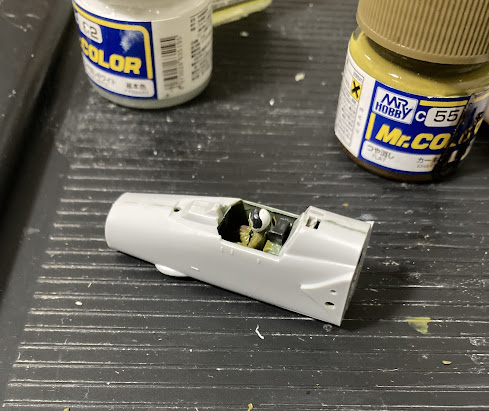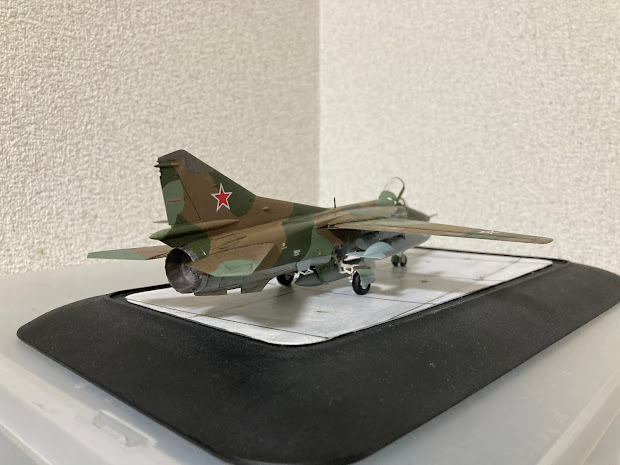Another day another Discord group build. What is it this time?
Ladies and gentlemen, I give you, 'Anything Mig.'
That's the one. Well, at least that's the one I'm going to be building.
The Mig choice form my local model store had this and a '25' but quite frankly that looked dull so a 27 it is. Let's have a look at what I got for my money.
The Mikoyan MiG-27 (Russian: Микоян МиГ-27; NATO reporting name: Flogger-D/J) is a variable-sweep ground-attack aircraft, originally built by the Mikoyan-Gurevich design bureau in the Soviet Union.
It is based on the Mikoyan-Gurevich MiG-23 fighter aircraft, but optimised for air-to-ground attack.
Unlike the MiG-23, the MiG-27 did not have widespread use outside Russia, as most countries opted for the Mikoyan-Gurevich MiG-23BN and Sukhoi Su-22 instead.
It remains in service only with the Kazakh Air Forces in the ground attack role. All Russian, Indian, Sri Lankan and Ukrainian MiG-27s have been retired. I know how it feels...
There's a hint regarding the subject on the side. Can you see it? Contains the parts for one model. This could be the Rosetta stone for the future, helping us translate all those different languages.
MiG-27D
Mikoyan-Gurevich MiG-27D
All MiG-27D are MiG-27s (MiG-23BMs) upgraded to MiG-27M standard. It is very difficult to distinguish from the MiG-27M. 305 were upgraded.
So....
MiG-23BN
Derived from the MiG-23B, but powered by the R29B-300 engine. This gave the advantage of making this variant exportable (the AL-21F was a restricted engine at the time, unlike the R29B-300). The R29B-300 also offered commonality with the MiG-23MS and MiG-23MF fighter variants already sold to the rest of world. It was armed with the GSh-23L cannon, with 200 rounds.
So...
MiG-23B
The first Flogger attack variant was powered by the AL-21F. Only 24 were produced, due to a lack of engines (the AL-21F was destined for the Sukhoi Su-17/22 and the Su-24 Fencer). It was armed with the GSh-23L cannon, carrying 200 rounds.
Not sure that is completely helpful.
Not sure that is completely helpful.
Just $6.00 to American dudes. To be fair that's good value. I will have some fun with this.
Let's lift the lid on this shall we? Well, the box is full of plastic so that's a good start.
Yeah, That's more like the colour I want.
I've painted the scheme now but just the intake areas to go. Here I am waiting for the glue to dry. Camouflage hides a multitude of sins so for a non-spray gun modeller, Camo and weathering is the way to go.That's coming along nicely.
The underside needs a coat of grey too.
Adding some feet to stand on.
A flogger, decals, instructions and a tip sheet. That's ticking all the boxes so far.
The wings, the pilot and the wheels.
Drop tanks and canopies. I'll keep the glass in the bag for now.
The decals look smart. Personally I don't need every microscopic marking. I also don't want four stars so this is, for me, the perfect balance.
Preparing the main body. Mapping out the camouflage. I started with a khaki colour but as you see later I changed that for a mid-brown. Obviously I'm no rivet counter as my idea of colour choice is... Yeah I like that colour here.
Cleaning up the joints with a bit of emery cloth. The joins were fine. Fine is the summary of this model I think.
Painting the anti-glare area.
Adding the nose and obviously forgetting the weight in the nose. It's what I do. When you have been modelling as long as I have (From before the invention of colour) you can get into the habit of skipping around the instructions. The down side is that you can miss bits and so often do I miss the weight in the nose of a jet. Ho hum. Such is life.
As I mentioned earlier, the body actually fits quite well. I have had issues with side split jets before but I didn't need much work for this one. The side fit issue is probably the reason I don't buy more fourth/fifth gen jets.
Leaving the emery cloth in the picture to prove that I used it
This is mostly mapping out the making scheme to give me guidelines to follow. I'll do the sides of the fuselage when the intakes are on.
The plastic looks perfectly good and plasticy for the money. Always remember folks that I am a tabletop modeller. I don't have a workshop or endless supplies and all I require from my model is a good quality, table top' result.
Looking at the individual sprues we have...
The fuselage and bombs... Spoiler, I thought it went together nicely. The carpet monster had one of the bombs but presumably didn't find it to it's taste as he let me have it back later.
The carpet monster had one of the wheels as well but again presumably didn't find it to it's taste as he let me have that back later too. No endorsement from the carpet monster for this one.
Painting the bombs and internal bits and bobs. You gotta love your bits and bobs.
Putting the cockpit together. You have to remember here too that as I am not going to spray this so I don't want you to get to close to the finished result. Arms length modelling in a nutshell. Because of that I am happy with a simple cockpit. I'm certainly not going to be super modelling anything here. I'll try and make the pilot look like a pilot as that is what we can see at the end of the day.
Looking at the finished cockpit, I think am am completely satisfied. What do you think? How much detail do you demand from your models?
The MiG-27 shares the basic airframe of the MiG-23, but with a revised nose – nicknamed "Utkonos" ("Platypus") or "Krokodil Gena" in Russian service, first introduced on the MiG-23B.
Built without radar in favor of a downward-sloping profile for improved pilot visibility, a laser rangefinder and marked-target seeker. Among its test pilots, it was also called "Balkon" ("Balcony") because of the increased frontal view from the cockpit. Additional cockpit armor was installed, along with a totally new nav/attack system.
This is mostly mapping out the making scheme to give me guidelines to follow. I'll do the sides of the fuselage when the intakes are on.
Don't forget to check both folded and extended. We don't want any unpainted spots.
We talked about my habit of skipping around the instructions.
Sub-assemblies are a prime example. They develop throughout the build. That allows for sub-assemblies to dry properly as they come on.
Here we have the drop tanks under construction. You can see the tags and seams that will need be cleaning as we go.
Fortunately the missing weight is not a problem when the wings are extended.
Dissatisfaction with the MiG-23BN led to the further development of the basic airframe to accommodate a stronger undercarriage, simpler intakes and a shorter exhaust nozzle.

And we are ready to finish of the model. Missiles and canopy.
We can have a look side by side of the same stage before and after a bit of weathering

It gives the model a bit of life.
A quick mid build slideshow.
Stop showing off... Can you see the model missing a nose wheel. The carpet monster must be looking after it for me.
Time for the decals methinks...
They went on fine. I don't do the fixing solutions. I don't do the different varnishes either. The more coats the more uneven the finishes when you are a brush painter.
In accordance with the MiG-27's strike and low-level attack requirements, provisions were made to mount missiles and precision-guided munitions, as well as retaining a nuclear capability in line with other Soviet combat aircraft by introducing specialized navigation systems.
Finally adding a simple base. A cheap plastic plate from the local 100 yen shop. Cardboard sheet to represent a concrete hard standing area and we are done.
I'm ready for my close up Mr DeMille.
The MiG-27 entered frontline service with Soviet Air Force Tactical Aviation in 1975, with the 722nd Regiment. It replaced earlier MiG-23B/BN and outdated Sukhoi Su-7 attack aircraft and equipped 22 of the 40 Soviet fighter-bomber regiments, being deployed all over the Soviet Union and other Warsaw Pact countries.
Soviet MiG-27s were permanently deployed to five foreign countries: East Germany, Hungary, Poland, Czechoslovakia and Mongolia until the 1990s.
The MiG-27 entered frontline service with Soviet Air Force Tactical Aviation in 1975, with the 722nd Regiment. It replaced earlier MiG-23B/BN and outdated Sukhoi Su-7 attack aircraft and equipped 22 of the 40 Soviet fighter-bomber regiments, being deployed all over the Soviet Union and other Warsaw Pact countries. Soviet MiG-27s were permanently deployed to five foreign countries: East Germany, Hungary, Poland, Czechoslovakia and Mongolia until the 1990s.
Soviet forces used the MiG-27 during the later stages of the Afghanistan conflict in 1987–89, which was the only time the Soviets used this aircraft in action. During the initial stages of the war, MiG-27s were not deployed to support ground troops in combat, as the Sukhoi Su-17s of the Turkestan and Central Asian military districts together with DRAAF Su-7s were considered sufficient to support the 40th Army's operations against the Afghan Mujahideen. However, in 1988 it was decided to deploy MiG-27s to support the existing forces in theatre. The 134th APIB, formed of three squadrons of MiG-27D/Ms and MiG-23UB trainers, was deployed to Shindand Air Base in October after extensive training in Kazakhstan. The most modern variant, the MiG-27K, was not deployed due to its lack of armour for the pilot. MiG-27s, in common with all other Soviet attack aircraft in the conflict, were limited in effectiveness by the 5,000 metre (16,400 ft) minimum altitude imposed due to the threat from MANPADs. As such they were only able to deploy unguided bombs and rockets against Afghan targets. Missions included bombing of supply convoys, night bombing of troop concentrations, scattering landmines with cluster munitions, and marking or illuminating targets for artillery with SAB-100 flare bombs. The 134th regiment remained in Afghanistan until the Soviet withdrawal, taking part in the siege of Kandahar. They were withdrawn on the 4th February 1989, flying to Kalay-Mor airbase in the Turkmen SSR where they waited in reserve until March of that year, when they returned to their home base in Kazakhstan.
Around the same time, MiG-27s started to be gradually replaced by more advanced Sukhoi Su-24 and Su-25 aircraft in the ground attack role at home. Other MiG-27 units, such as the 642nd GvAIP, re-equipped with MiG-29 fighters.
The table top modeller completes his arms length model. Your thoughts?





















































Comments
Post a Comment